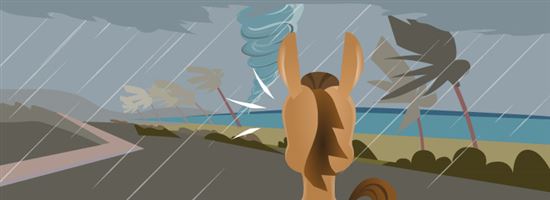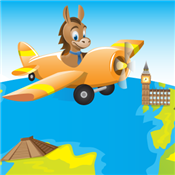Facts about Hurricanes
Hurricanes can cause mass destruction hundreds of miles from where they originate. They can travel at tremendous speeds and even cause a loss of life.
 |
| © CreditDonkey |
- What are other names for a hurricane?
- What causes a hurricane?
- What was the biggest hurricane in the world?
- Do hurricanes have a purpose?
- Do hurricanes cool the ocean?
- What is the most dangerous thing about a hurricane?
- How long can a hurricane last?
- How fast can a hurricane go?
- How far does a hurricane travel?
- Why do hurricanes have names?
- Are hurricanes named in alphabetical order?
- How dangerous are hurricanes?
- Which are the 5 deadliest hurricanes?
- Is there such a thing as a category 6 hurricane?
- Is the eye of the hurricane really calm?
- What was the name of the first hurricane?
- How bad is a category 1 hurricane?
- How many category 5 hurricanes have hit the US?
- What is it like being in the eye of a hurricane?
- What is the strongest part of the hurricane?
- Was Hurricane Katrina a category 5 hurricane?
Facts about Hurricanes
What are other names for a hurricane?
A hurricane is a violent tropical storm. You may hear them called cyclones, tropical storms, or typhoons, but they all virtually mean the same thing. The area the storm hits typically determines its name. In the South Pacific and Indian Ocean, it's a cyclone; in the Atlantic and northeast Pacific, it's a hurricane, and in Asia, it's a typhoon.
What causes a hurricane?
Hurricanes are a combination of high-speed winds and warm water. They form over warm oceans. When the warm air rises, the atmosphere replaces it with cool air. That cool air then warms up, and again rises. This causes the storm clouds that start rotating with the Earth. As it continues, the cycle doesn't end and a hurricane begins.
What was the biggest hurricane in the world?
The Galveston Hurricane of 1900 was the largest hurricane thus far in the world. It caused as many as 12,000 deaths.
Do hurricanes have a purpose?
Hurricanes do cause a lot of destruction, but they also serve a few good purposes. They bring rainfall to the areas that often need it the most; they can balance out temperatures between the North and South Poles and the equator; and they can replenish the life of islands and plants by transplanting sand, nutrients, and seeds.
Do hurricanes cool the ocean?
Hurricanes do cool the ocean, but it depends on the temperature of the ocean at the time of hurricane development as to whether they cool down enough. In cases like Hurricane Katrina, the water temperature was so high that the hurricane kept going despite the slightly lower temperature of the ocean water as a result of the hurricane.
What is the most dangerous thing about a hurricane?
The storm surge is the most dangerous thing about a hurricane. It can claim lives and cause destruction. The storm surge is the uprising of water caused by the strong winds. The water can sweep over areas at more than 20 feet high and hundreds of miles long.
How long can a hurricane last?
Hurricanes can last as little as one day or go as long as one month. It depends on the circumstances surrounding the hurricane. The longest-lasting hurricane thus far is Hurricane John. It lasted 31 days.
How fast can a hurricane go?
Hurricanes typically have wind speeds of at least 74 miles per hour, but they can get as fast as 157 miles per hour.
How far does a hurricane travel?
Hurricanes can travel as far as 100 miles. After that point, they become a tropical storm.
Why do hurricanes have names?
Before the 1950s, hurricane experts tracked hurricanes by the year that they occurred. As hurricanes became more frequent, though, it became hard to keep track of them. This is when they started coming up with short female names for hurricanes. By 1978, both male and female names were used.
Are hurricanes named in alphabetical order?
The World Meteorological Organization has an alphabetical list of names for hurricanes. The names can be reused after six years. The exception to the rule is any name of a devastating storm - those names are retired for life.
How dangerous are hurricanes?
The largest threat of a hurricane is the storm surge. The waves that can reach over 20 feet high can destroy buildings, claim lives, and even cause road damage. The heavy rainfall and ensuing flooding can also cause loss of lives and immense destruction throughout the area.
Which are the 5 deadliest hurricanes?
The five hurricanes that took the most lives are:
- Galveston Hurricane of 1900
- Lake Okeechobee, Florida, Hurricane of 1928
- Hurricane Katrina of 2005
- Cheniere Carminada, Louisiana, 1893
- Sea Islands Hurricane of 1893
Is there such a thing as a Category 6 hurricane?
The Saffir-Simpson Hurricane Wind Scale currently categorizes hurricanes on a scale of 1 to 5. That's not to say that there haven't been hurricanes that could be categorized a Category 6, but that category doesn't exist as of yet.
Is the eye of the hurricane really calm?
The eye of the hurricane is the complete center of the hurricane. The strong winds that blow everywhere around the hurricane don't reach the center, or the eye. The water in the eye is warm and the air sinks into the water, bringing down the pressure of the storm in that area. Oftentimes, the eye has clear skies—clear enough that you can even see it from space.
What was the name of the first hurricane?
The first storm to have a human name is Hurricane Alice. It occurred in 1953 and was one of the strongest Atlantic hurricanes to occur.
How bad is a Category 1 hurricane?
A Category 1 hurricane has wind speeds between 74 mph and 95 mph. The winds at this speed can cause damage to things like roofing, siding, and gutters. It can rip branches off trees. It can cause a loss of power for several days, but the damage is hardly ever catastrophic.
How many Category 5 hurricanes have hit the US?
There have only been four Category 5 hurricanes in the US. The most recent was Hurricane Irma, which occurred in August 2017.
What is it like being in the eye of a hurricane?
Inside the eye of a hurricane, it can feel very calm—almost an eerie calm. Just outside of the eye, at the eye wall, the winds can be so treacherous though, that the eye feels threatened. It's like the calm before the storm.
What is the strongest part of the hurricane?
Typically, no matter the direction of the hurricane, the right side is the strongest. The right side generally has the strongest winds, while the left side has the weakest wind speeds.
Was Hurricane Katrina a Category 5 Hurricane?
Hurricane Katrina was a Category 5 hurricane only in the Gulf of Mexico. When it touched down in Louisiana, it was a Category 3 hurricane.
Write to Kim P at feedback@creditdonkey.com. Follow us on Twitter and Facebook for our latest posts.
Read Next:






